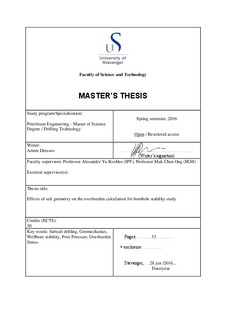| dc.contributor.author | Derusov, Artem | |
| dc.date.accessioned | 2016-09-21T12:10:59Z | |
| dc.date.available | 2016-09-21T12:10:59Z | |
| dc.date.issued | 2016-06-29 | |
| dc.identifier.uri | http://hdl.handle.net/11250/2409300 | |
| dc.description | Master's thesis in Petroleum engineering | nb_NO |
| dc.description.abstract | Pre-drill pore pressure and fracture gradient predictions are important for successful drilling and well construction. There are numerous different methods for calculating the pore pressure in shales without direct measurements in the wellbore. All of the methods are based on interpretation of geophysical data, such as acoustic velocity and/or formation resistivity, which are sensitive to the effective stresses in the formation. Standard methods (like Bower’s or Eaton’s) utilize overburden effective stress for pore pressure prediction. Those methods are developed for regions with normal faulting stress regimes, where the direction of maximum compression is vertical and magnitude is equal to the weight of overburden. Due to the fluid-like behavior of salt on a geologic time scale, in situ stresses around salt structures may deviate significantly from regional tectonic directions, which in turn may significantly affect wellbore stability.
The main goal of this study is to quantify the difference in pore pressure and overburden stress predictions in a salt-related basin calculated with different methods, such as: a standard density integration and finite element modeling (FEM) using Plaxis software. The input geometry for geomechanical modeling was based on EDGE 2004 synthetic velocity model. The input geomechanical parameters were calculated from seismic interval velocity using empirical correlations developed for Gulf of Mexico.
In this study, it is demonstrated that a standard overburden calculation methods (based on density integration) can lead to errors in pore pressure prediction with magnitude up to 30 MPa; while 2D FEM is able to capture stress perturbation around salt structures. In majority of cases pre-drill developing of 3D FEM geomechanical model may not be feasible, because it is time consuming; while 2D geomechanical model is relatively quick and may significantly affect drilling decision to reduce the risk of well-bore instabilities caused by influx of formation fluids, losses of drilling fluid into formation, wellbore breakouts, tight hole intervals. | nb_NO |
| dc.language.iso | eng | nb_NO |
| dc.publisher | University of Stavanger, Norway | nb_NO |
| dc.relation.ispartofseries | Masteroppgave/UIS-TN-IPT/2016; | |
| dc.subject | petroleum engineering | nb_NO |
| dc.subject | petroleumsteknologi | nb_NO |
| dc.subject | wellbore stability | nb_NO |
| dc.subject | subsalt drilling | nb_NO |
| dc.subject | geomechanics | nb_NO |
| dc.subject | pore pressure | nb_NO |
| dc.subject | overburden stress | nb_NO |
| dc.subject | boreteknologi | nb_NO |
| dc.title | Effects of salt geometry on the overburden calculation for borehole stability study | nb_NO |
| dc.type | Master thesis | nb_NO |
| dc.subject.nsi | VDP::Technology: 500::Rock and petroleum disciplines: 510::Petroleum engineering: 512 | nb_NO |
